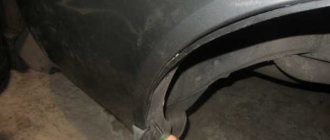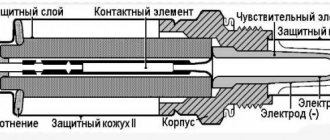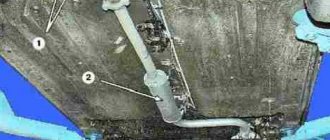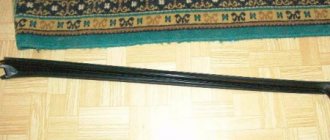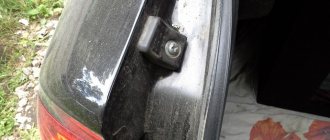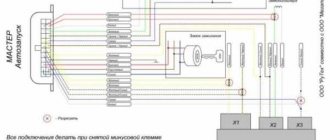How to replace a muffler on a Priora
You will need : drive the car into the inspection hole, prepare tools (13mm socket, 13mm wrench, mounting blade).
Removing the Priora muffler:
- Unscrew the nut of the bolt securing the clamp that connects the pipes of the additional and main mufflers, using a 13mm socket. Using the same tool, we hold the bolt on the other side from turning.
- Remove the clamp by loosening the nut of the other clamp mounting bolt.
- Remove the O-ring by pulling the muffler back and moving it to the side.
To release the Priora muffler mount:
- Remove the muffler bracket from the hole in the front cushion by prying it with a mounting spade.
- Remove the muffler bracket from the hole in the rear cushion, pry it up with a mounting blade and lean on the muffler pipe.
- Remove the main muffler.
Installation of the muffler on the Priora is carried out in the reverse order, after first replacing the rubber muffler cushions (gingerbread) with new ones. Finally, we rock the muffler and check that it does not touch the body or fuel tank.
Which muffler to put on Priora
Catalog numbers depending on body type:
- Muffler Priora sedan/station wagon (VAZ 2170 and 2171) (2170-1200010-00)
- Muffler for Priora hatchback (VAZ 2172) (21720-1200010-00)
The approximate price of a muffler for a Priora is 1500 rubles.
By the way, do you know how to install a double muffler on a Priora?
Replacing a muffler on a Priora
Today it is difficult to imagine a car without a muffler, but this is how the first cars were created. It is not surprising that in those early years the public had a negative attitude towards the car, considering it the cause of all disasters and problems. It was only in 1884 that the first noise-reducing device appeared; it was installed on the Panhard-Levassor model. From this moment a new history of the global automobile industry begins, which continues to this day. Next, we will talk about mufflers installed on the Lada Priora, about possible malfunctions of the part and how to replace the muffler yourself. So, let's go. What is a muffler? Design:
- an exhaust manifold;
- main muffler;
- auxiliary muffler.
All components are interconnected in such a way that they form a single, interconnected, hermetic system. But it is precisely because of this interconnectedness of individual components that the failure of one part to work negatively affects the operation of other components.
Direct flow on Priora hatchback
I was sitting at home in the evening - there was nothing to do...) Suddenly, by chance, I wanted the most unrealistic drive and dynamics. From which came the idea to carry out a standard procedure to improve the dynamic characteristics of the car, in other words, chip the baby and pile on.)) Delicately and carefully taking the brain out of my combat unit, it was taken to a dark office, where they made it clear that the Euro-4 standard is not good , if you have a vigorous spirit in you.)
The firmware was made to the Euro-2 environmental standard and with 1 lambda disabled, because it was not advisable to do Euro-0, due to the endangered population of polar bears and other good, kind little animals. Unfortunately, it was not possible to settle on the usual firmware, I’m a priority. It was decided to change the standard exhaust system to a peppy collective farm exhaust with 51 pipes. In short, this is a 4-1 spider that everyone is already tired of
, the continuation of which is no longer the standard resonator, but 51 pipes from the same manufacturer painted in stunning black gloss.)
As a result, a terrifying exhaust sound was obtained due to a muffler that had burned out over 5 long years. After driving for a week, it was decided to replace the muffler
and get rid of the vibrations that appeared throughout the body due to the absence of corrugation by sawing it into the resonator pipe.)
the result was partly pleasant. At low gas speeds, the exhaust sound began to meet the standards for driving around the city, now I was not afraid for the hearts of grandparents who were accidentally passing nearby.) But...) When the throttle is open and the speed breaks all records, the exhaust sound begins to excite and this is an integral plus, as for me .) Still, piloting the device should bring pleasure and give positive emotions when needed. What about the conclusion for all the work done? Consumption decreased by one and a half liters in the urban cycle. Dynamics - the increase on the driver’s side turned out to be not very obvious, that is, as for me - yes, faster and more responsive, but the difference from stock did not seem so significant. From the passengers' side, the car's dynamics indicator seemed very obvious, because it evenly presses into the seat in both 2 and 3.) Drive - well, here the exhaust gives a lot of positive emotions ala "burnt-out resonator", I and my valiant passengers like it.)
Malfunctions
The Priora exhaust system suffers mostly from corrosion processes that occur due to condensation: vapors settle on the hot surface, which, as the metal cools, turn into destructive drops. Overheating also causes system destruction. The main faults include the following:
- reduced noise reduction;
- breakdown of sensors;
- broken fastenings;
- mechanical defects of parts.
A decrease in the ability to suppress noise occurs due to damage to the partitions. This malfunction is usually indicated by rattling sounds when the engine is turned on. Whatever the malfunction, it requires an urgent procedure for replacing the muffler, because if you postpone this action until later, the problem can worsen and lead to very unpleasant consequences, because the muffler not only reduces the noise level, its second job is to protect against penetration toxic fumes into the cabin, which can lead to poisoning of the driver and passengers. In addition, the muffler affects the operation of the engine, maintaining its power. That is why it is important to approach the issue of replacing the muffler with the utmost care.
How to make the exhaust on a Priora louder
DeHuC
, can you still be as detailed as possible about the sounds? From the engine side, from the street, both at idle and under load, in the cabin from below, how can you hear it? Is Kat noisy? What's louder, a cat or a spider? Can you hear the Stinger muffler at idle in complete silence?
It’s interesting if you install a stinger spider, a pipe, and some kind of exhaust from another car... from a two-liter Lancer or something else... Will the overall noise be quieter?
I read all the topics here regarding the muttering of the muffler, the diesel sound of the catalyst and the simply loud exhaust of the Priora, but I still couldn’t find an answer to my question, so I decided to write a kind of summary topic. So, all owners of the VAZ-2112 (1.5 l. 16 kl, Euro-2) probably noticed that something was wrong with the exhaust of the priors. namely the following: 1. If it is located outside, then it seems that the Priora has forward flow 2. While driving, especially under load, the engine works like a diesel engine, with a characteristic rattling sound, instead of the smooth and even pleasant hum of 2112 3. If you sit in the Priora and start the engine, then at XX you hear some kind of hum. which seems to be coming from below, which was not the case on 2112 (there, on XX, you can hardly hear the engine at all).
Actually, the reasons for this: 1. This is the fault of the main muffler 2. This is the fault of the catalyst (on 2112 it was under the bottom and was not so audible, and it had a different design). At the same time, catalysts are made of cast iron and metal, the former are a little quieter. 3. And this is because of the entire exhaust system: on the Prior, the pipes are thinner, as are the walls of the resonator. which causes resonance and hum.
Tips for choosing
The first thing you should pay attention to when choosing a muffler is the material. The best option is aluminized steel; it is stronger than stainless steel or zinc-alumina steel and is resistant to rust. This part will last about six years. The second is the device of the node. Silencers are divided into several types
- by design;
- degree of noise reduction;
- dimensions;
- presence/absence of an additional body layer.
Third, you should pay attention to the manufacturer and the country of manufacture. As a rule, Polish and Turkish companies cannot please you with their quality, while the Germans, Japanese, and even our domestic parts are quite suitable for the job. And lastly, it’s worth remembering that each model is equipped with a certain type of muffler and you need to know this when buying a part. The price for a standard muffler for the Lada Priora is approximately 3,400 rubles.
How to weld a muffler in the garage?
If the muffler is burnt out and the damage site is large, more comprehensive repairs may be required.
It is not difficult to recognize serious damage - first a “whistling” sound appears, which only intensifies if left unattended.
Smoke from the exhaust pipe enters the cabin, making it impossible to drive the car.
The most reliable method of repair is welding the damaged element. There are two ways here - entrust the work to a master or do it yourself.
In the second case you will need:
- Welding machine (it is better to choose a semi-automatic type device);
- Tool set (hammer, wrenches, screwdrivers, etc.);
- Brushes with metal bristles, as well as sanding paper;
- Grinder with attachments;
- Heat-resistant paint;
- Pieces of metal sheets having a thickness of 1-2 mm.
Muffler repairs are carried out exclusively in the damaged area (in the place where the unit burned out). If there are rusted areas, it is advisable to remove them completely.
Then proceed like this:
- Cut out a fragment of the resonator or muffler;
- Remove rusted areas;
- Pay attention to the condition of the internal components. If the partitions and tubes inside the muffler are damaged, restore them or replace the unit as a whole.
For welding, it is better to use a semi-automatic welding machine, which carefully patches the damage.
This is due to the fact that carbon dioxide used in the welding process prevents the metal from overheating and changing its structure. During the repair process it is worth making continuous seams.
Read more about welding machines in the article - how to properly weld a car body.
If rust has reached the junction of the pipe and the casing, you need to cut out the corroded area that has become unusable, then replace the damaged unit and weld the muffler back into place.
At the final stage, it is worth painting the surface, because at the factory this work is performed only formally. This stage should not be skipped, because with its help it is possible to extend the service life of the muffler (we will talk about this below).
Replacement
- Unscrew the upper and lower fasteners of the clamp holding the resonator and muffler. Moreover, if we unscrew the top one completely, then the bottom one is a little more than half unscrewed.
- We disconnect the resonator and muffler, remove the seal.
- We remove the rubber cushions, slightly lift the muffler up, and dismantle it.
- We install the new muffler in the reverse order.
Muffler for Priora - price, installation and analogues
Problems with the exhaust system send drivers to maintenance. Whatever muffler you install, it will burn out over time - no matter how much it costs. The muffler, also known as the exhaust, of a Priora sedan, hatchback, and station wagon is the same and also burns out over time. Of course, the main muffler on the Priora is better made of stainless steel - despite the fact that it is more expensive. The price for example is STT - 4950 rubles, and Mute stainless steel - 4500 rubles, Stinger (stinger) - 4100 rubles. Replacing a muffler, although not a common thing, car enthusiast forums are regularly updated with fresh articles devoted to the problems of the Lada Priora car exhaust, operation, and replacement of the middle part of the car exhaust system, clearly indicating the relevance of the issue. The exhaust system is the exhalation for a car - it is important, just like the intake system. In this article we have collected most of the most pressing consumer questions.
What to do if the muffler burns out: general recommendations
As noted above, the main evidence of a muffler burnout is the appearance of a loud noise.
To find the location of the damage, just look under the bottom of the car and find the location of the fault.
Most often, problems arise at the bends of the exhaust pipe, where the metal has to withstand the greatest stress.
At the initial stage, the damage may be small, but over time traces of corrosion appear. As a result, a small hole can turn into a large hole.
Regardless of the chosen repair option, it is advisable to clean the burnt-out muffler using a special brush with metal bristles, then treat the area with sandpaper and rinse with a solvent. If this is possible, the unit does not need to be dismantled.
If the muffler burns out, the following repair options suggest themselves:
- Classic welding. The advantage of this method is the reliability of the repair. The problem is that it will not be possible to weld the product with one seam - it is advisable to make a special patch.
- Cold welding. Here, a special 2-composite material is used for repairs, which is first mixed and then applied to the place where the muffler burns out. Next, the mixture hardens and ensures the tightness of the area.
- Insulating material. If the fault occurs on the road, you can use insulating material (available in automotive stores). If you have access to a garage, you can find the necessary material yourself.
Standard muffler - article number and price
The VAZ 2170 Priora is equipped by the factory with spare part item number 2170-120010. Made of light sheet steel with a thickness of 0.8-1.1 mm. Connecting inlet pipe with a diameter of 48mm. Inside the muffler chamber (an oval tank - popularly known as a barrel) there is a series of parallel chambers for the last stage of dampening the force of the sound wave of the exhaust gases. The exhaust pipe allows you to install different types of muffler attachments to add uniqueness and change the sound characteristics of your car's exhaust. The price of such a standard muffler is in the range of 1200-1600 rubles. Of course, you can go much further.
Main malfunctions of the Lada Priora muffler
The main reasons for replacing or repairing this part of the exhaust system are often burnout, rupture of the tank with loud bangs inside, loss of integrity, and deformation of structural parts. Loud roar when operating at high speeds, impacts on the body. An important factor in the failure of the Lada Priora muffler is metal corrosion, which occurs when the protective coating is lost as a result of overheating and condensation of water vapor on the walls.
Fluid in the muffler
accumulation of liquid in the cavity of the barrel or, as experienced car enthusiasts joke, “drips from the end”) is a fairly common phenomenon. It is important to find out what kind of liquid collects inside. Often the reason for this is water condensation formed from the difference in the operating temperature of the unit and the external environment. It has a negative effect on models made of iron-zinc steel that are poorly protected against corrosion. Models made of steel with a share of aluminum or stainless steel are less susceptible to this influence. Many people find a way out by drilling a drainage hole in the corner of the tank. If you find antifreeze or antifreeze in the liquid, it’s time to sound the alarm. Malfunction in the tightness of the cooling system of the car engine (loss of integrity, wear of the cylinder head gasket, depressurization of the cylinder block). You should immediately check the operation of the cooling system and eliminate the cause to avoid further negative consequences.
Loud roar at revs
The sound of the exhaust gases changes when the engine speed reaches over 3000. The reason for this behavior is often the burnout of the partitions inside the resonator, the middle part of the exhaust system, or a clogged exhaust catalyst. Loss of joint density, structural integrity as a result of corrosion, burnout of individual elements, cracks at the joints of parts. All this indicates the end of the service life of the spare part. The only reliable solution is to replace the faulty system unit. Eliminating these defects with a hammer and a welding machine is a temporary solution.
Why does the silencer fire?
Loud pops occurring inside the exhaust system suggest a malfunction. There is a malfunction, of course, but it lies in the operation of the car’s engine. The shot occurs as a result of partial combustion of the gas-fuel mixture inside the cylinders and ignition of the residues already inside the exhaust gas removal system.
The “exhaust” only takes on all the consequences of the malfunction; soon it itself may fail. You should check the spark plugs, spark plug wires, and the entire fuel supply system.
Knocks from under the body
Knocking, vibration, extraneous sounds when driving are unpleasant things for the car owner's ear. The culprit is often the impact of parts of the exhaust system on the underbody and gas tank of the car. There are several reasons for this behavior. Rubber fasteners of exhaust system parts are subject to priority inspection. Loss, wear and tear of which weakens the structure; replacing them will not be difficult. There may be a loss of tightness of the clamp connections of the parts (it is necessary to tighten the fasteners, it is possible that the clamp mounting bolts need to be replaced). Installation of an unsuitable model, with a difference in the bending angles of the pipes of the muffler design. This is fraught with constant contact with the body, chassis, gas tank, vehicle (requires immediate intervention). Reducing the vehicle's ground clearance by installing a lowered suspension (knocks on the beam). This can be solved by installing movable fasteners of a suitable configuration.
How to determine whether a muffler is faulty
In fact, this is the element that is most often exposed to high temperatures. Over time, this element fails due to corrosion, burnouts, impacts on uneven roads, or constant accumulation of condensate in the pipe .
Corrosion causes the muffler body to lose its seal.
If the muffler is faulty, the driver will immediately notice this:
the “glushak” will start knocking on the body;
the car will lose its dynamism;
you can hear pops and a strong roar in the exhaust pipe;
Antifreeze is leaking from it.
Why does the silencer fire?
This can seriously damage the integrity of the pipes. Therefore, at the first claps, you need to check the following car systems:
spark plug wires (if, after replacing the spark plugs, the wires were connected incorrectly, problems with engine operation may occur);
That is, the occurrence of pops is not related to the performance of the muffler itself, but directly affects the service life of the pipes.
Knocks from under the body
The muffler may knock:
about the bottom of the car;
about the fuel tank body.
In any case, the impact of the pipe on the surface quickly deforms the coating, as a result of which the part loses its tightness. There are two reasons why it lost its original position under the body and began to hit other surfaces while driving:
The rubber suspensions are worn out. You just need to buy new rubber bands and replace them. The muffler will return to its normal position and the knocking will stop.
After replacing any elements of the exhaust system. It is quite possible that certain parts were connected incorrectly, the nuts were not tightened correctly, the reinforced gasket was inserted on the wrong side, etc. To understand this problem, you will need to carefully check all connections and elements. Often knocking noises occur due to improper installation of the short stroke.
Manufacturers of mufflers and prices of analogues for Priora
The choice of Priora mufflers available to consumers is huge. Many of them differ in the name of the manufacturer's plant. Let's look at the main ones that differ in production method and materials:
- Muffler made of steel with a large admixture of aluminum (Lada-Image, EDEX, PHOENIX, etc.), resistant to corrosion, suitable for all body types. Its disadvantage: the presence of welding seams in the design of the part. Price – from 2500 rub;
- The sunset type of production (Phobos, NAAZ, Avtokomplekt, etc.) has the main advantage that the part is produced without welding technologies or the use of stainless steel, so it has an increased service life. The price of such a “stray” is from 3000 rubles;
- Budget muffler (“VVV Tolyatti”) uses iron-zinc steel in production, is short-lived, suffers greatly from corrosion, and wears out quickly. The only plus is the price of the spare part is approximately 1400 rubles;
- A separate type is stinger (spider) forward flow exhaust systems (“MUTE”? “StinGer-auto”, etc.). Advantages - a slight increase in vehicle traction, choice of high-quality materials in manufacturing, long service life.
Prices vary greatly depending on the manufacturer, from 4500 rubles. Remember, it’s better to buy one good exhaust than two bad ones, and your Priora will be satisfied.
Removal and installation of the main muffler of the Lada Priora
Replacing the muffler on a Priora yourself is possible within the garage. The presence of an inspection hole will greatly help the replacement event. Replacement can also be done using a jack. In most cases, the main muffler and resonator are dismantled; other parts rarely break.
- To remove the main part, unscrew the fastening and connecting clamp. The module is disconnected from the resonator.
- The resonator hangs on rubber hangers, lift it up and unfasten it.
- We discard the sealing ring located between the nodes; when reassembling, a new gasket is used for connection.
The number of exhaust rubber bands on a Prior hatchback and sedan is different. The exhaust pipe on the Prior is attached to the exhaust pipe with a bolted connection, which is sometimes difficult to unscrew; it is advisable to pre-treat the bolts and nuts with WD-shkoy. Often after dismantling it is necessary to replace them with new ones. Before installation, it is recommended to clean all connecting elements from fumes and dirt. Removing the exhaust of priors “on the knee” is a tedious task, but doable!
How to replace the rear muffler on a Priora with your own hands
So, it’s worth noting right away that it’s most convenient to carry out this repair in an inspection hole. If there are no such conditions, then it is necessary to at least raise the rear of the car with a jack.
So, apply a penetrating lubricant to all threaded connections, and then wait a few minutes until everything settles!
Now we unscrew the two nuts of the coupling bolts of the clamp connecting the resonator to the Priora muffler.
After this, you need to move the clamp to the side and disconnect the exhaust part. If you can’t do this manually, you can carefully and without extra effort hit the joint a couple of times with a hammer.
As a result, we get the following picture.
Now the muffler remains hanging only on rubber hangers, from which it must be removed.
As you can see in the top photo, one rubber band is located almost at the very rear of the muffler, and the second is closer to the beam, that is, at the other end.
Then we remove the muffler completely from the car and replace it with a new one. Installation is carried out in reverse order. When performing this repair, it is best to also replace the bolts and nuts, as well as the clamp itself, with a new one. Carefully inspect the connecting ring for damage and, if necessary, replace it with a new one.
The price of a new muffler for a Priora can vary quite a lot, and depends on the metal used, as well as on the manufacturer. Prices can vary between 1000-2000 rubles.
Folk repair methods and features of their application
If the muffler is burnt out, you can use traditional repair methods (some mentioned above):
Special tape.
The exhaust system includes pipes and tanks. Of these elements, tanks are more susceptible to burnout, which is due to the accumulation of condensate and “torsion” inside the gases.
In addition, the thickness of the metal frame is lower here, which is also an additional factor.
Situations are possible when pipes are damaged due to a mechanical impact on a stone or in the event of driving into a hole at speed.
A crack may also appear in the event of a sudden change in temperature (when driving into a puddle). If the inspection shows damage to the pipeline, and the defect itself is small, thermal tape is used.
Its advantage is to ensure tightness and high speed of repair.
On the other hand, it does not provide sufficient rigidity, so the damage will definitely return.
Sealant.
Many car owners are confident that the best way to restore is to use a special sealant that ensures the rigidity of the joints and the joining of different elements.
It can also be used when installing a new muffler gasket or when installing connecting units with non-standard dimensions.
To prepare the composition, you need to take a piece of material, knead it (it should take the shape of plasticine), and then seal the damaged area.
Next, the treated area is leveled using a spatula. After 24 hours, you can get behind the wheel and go about your business. In addition, this method can extend the life of the exhaust system.
The main thing is to choose the right type of cold welding - it must withstand high temperatures.
Sealant may come in handy in one other situation. So, if the flange connecting two elements of the system is bent, or the sealing joint has lost its tightness, the damaged joint can be treated.
Insulating material.
You will need a piece of asbestos (loose or sheet), asbestos thread and copper wire. To soften the material, liquid glass is added, after which the burnt-out part of the muffler is filled with the mentioned mass.
The repair site is tightly wrapped first with asbestos thread, and then with copper wire.
The advantage of this method is the high speed of repair and the ability to delay major restoration work.
The design of the exhaust system "Lada-Priora"
The exhaust gas exhaust system on the Lada Priora is simple in structure and similar to the exhaust systems of most budget cars. It can be divided into three components:
- exhaust manifold with gas neutralizer;
- additional muffler including a resonator;
- main muffler.
All three parts are hermetically connected to each other. The main and additional mufflers are attached to the bottom of the car on rubber suspensions. The exhaust manifold is connected directly to the engine.
Priora is available in three body styles: sedan, station wagon and hatchback. Functionally, the exhaust systems of cars in different bodies do not differ from each other, however, due to the difference in dimensions, mufflers for different versions differ in the length of the pipes, the shape of their bends and the number of rubber suspensions. So, on hatchbacks the mufflers are somewhat shorter than on a sedan, and on station wagons the number of mounts will be greater.
1 - cylinder head gasket, 2 - exhaust pipe of the catalyst, 3 - reinforced gasket, 4 - corrugation, 5 - resonator, 6 - rubber suspensions, 7 - bracket, 8 - exhaust pipe, 9 - o-ring, 10 - rubber suspensions, 11 - main muffler, 12 — fastenings
Exhaust system malfunctions are most often associated with the main or additional muffler, so they are usually the ones that are replaced.
Main components of the Priora exhaust system
As already mentioned, this is not one element, but several:
- Timing (gas distribution system) exhaust valves.
- Exhaust manifold with particulate filter (catalyst).
- Oxygen sensor (Lambda probe) 2 pieces.
- Middle part with resonator.
- Tail section with muffler.
Each of these parts must be considered separately.
Release of gases in the cylinder head
This is part of the operation of the gas distribution mechanism. A full description of this mechanism is a separate issue of engine operation. It is enough to mention here that the 8 exhaust valves open in exhaust mode and the piston pushes the exhaust gases into the system. Namely, into the exhaust manifold.
Catalyst or particulate filter in the exhaust manifold
This is one of the most complex and expensive components of the entire exhaust gas system. Essentially, this is a device for afterburning unburned gasoline particles using catalysis. For this purpose, the thin walls of the longitudinal filter honeycombs are made of a special material. Contacting them, gasoline burns (figuratively). The output is ordinary water.
Set of Lambda probes for Euro-3 system
What is Euro 3 standard? In fact, this is the level of purification of car exhaust gases. It is according to the levels of vehicle access to Europe that these systems are distributed. There are several levels:
- Euro level.
- Euro 2 threshold.
- Euro-3 (basic for Priora).
- Euro-4 (Subsequent models and the latest “Priors”).
- Euro-5.
In the first option, a particulate filter was added to the exhaust system. It is mentioned above. But in system No. 2, electronics control has already been connected. A special, rather complex and expensive sensor was developed. Lambda probe or oxygen sensor. Thanks to a special coating, its resistance changes its value depending on the saturation of the exhaust gases with carbon monoxide. That is, carbon monoxide.
To more accurately understand the meaning of the Lambda probe, it is worth briefly describing the history of Euro standards. So.
To reduce toxicity, an afterburner was installed in the exhaust system (the particulate filter described above). This was the Euro system. Further, with the development of the electronic component of the control system, the idea of exhaust quality control came. And installed 1 oxygen sensor. It was placed in the system directly into the collector. Before the afterburner. This allowed us to make adjustments to the gas saturation table in the program. The system with one sensor was called Euro-2.
However, savvy motorists quickly realized that the particulate filter, which reduces engine power, can simply be thrown out. Which is what they began to do with success. Then, after the afterburner, another Lambda probe was inserted into the system. And he already informed the computer that the filter was not working. And accordingly, he again cut back on fuel. This became the new Euro 3 standard. Well, Euro 4 and 5 are just a modification of the software and replacement of fuel to the European level, respectively. The latter, if nothing interferes, should be carried out in Russia by the end of 2021.
This is what the oxygen sensors in the Priora exhaust system are for.
What is the purpose of the resonator in the Priora exhaust device?
It is also called an auxiliary muffler. It is an exhaust system pipe bent at an angle and having an extended section in one place. This makes it possible to initially smooth out the sound vibrations escaping from the engine when releasing gases.
The auxiliary muffler is located immediately behind the manifold and catalyst. And immediately behind it comes the muffler itself.
On some Priora models, two parts, the resonator and the main muffler, are made as a single unit. But the collapsible design is more convenient both in operation and in repair.
Roar, shooting, condensation and other reasons to look under the car
It's easy to spot muffler problems. It is difficult not to notice extraneous sounds coming from under the car, or a sharp change in the tone and volume of the response to pressing the gas. It is not uncommon to notice fluid leaking or even splashing from the exhaust pipe. All these are signs of malfunctions, but do they all indicate problems in the exhaust system?
Fluid in the muffler
Fluid dripping from the exhaust pipe is a common occurrence. However, it is worth distinguishing what kind of liquid it is. If it's water, there's nothing wrong with it. When the ambient temperature changes, moisture from the air condenses on the surfaces of the muffler. If a steel muffler is used, this can lead to corrosion, but usually the Priora exhaust system uses aluminized steel or stainless steel, which means that damage from water will be minimal. In cases of heavy accumulation of water, experienced motorists usually drill a drainage hole in the “barrel” of the muffler.
If there is excessive accumulation of water in the muffler, in winter you may encounter icing of the exhaust pipe
If antifreeze drips from the exhaust pipe, the fault should be looked for not in the muffler, but in the engine. The reason may be wear of the cylinder head gasket, as well as depressurization of the block itself. Antifreeze in the exhaust pipe is a symptom of serious problems, and if it is detected, you should immediately diagnose the engine.
Pops and shots from the exhaust pipe
Popping noises coming from the muffler indicate a malfunction. However, this is also a malfunction of the engine, not the exhaust system. Shots or pops from the exhaust pipe indicate that the mixture of air and gasoline does not burn out in the cylinder block, which means that when you hear them, you should check the spark plugs and spark plug wires, as well as the serviceability of the gas distribution mechanism. Problems with combustion of the mixture are not a symptom of a muffler failure, but they can be its cause.
Video: this is what pops from the muffler sound like
Knocking from under the car
A knocking sound from under the bottom of the car while driving or rattling from vibrations is an unpleasant phenomenon. The muffler may touch the gas tank or the underbody. There are several possible reasons for this.
- First of all, check the rubber muffler hangers. Their wear leads to loosening of the entire exhaust system. These mounts are sold at most auto parts stores. Their price usually does not exceed 100 rubles per piece. Replace the suspension with new ones and the knocking will stop.
- It is worth checking whether the clamp connecting the main muffler and the additional muffler is loose. If necessary, replace the fastening bolts and nuts. For replacement, it is best to use fasteners made of heat-resistant materials.
- Using the wrong model of muffler with pipe bends that differ from the original spare part can lead to contact between the exhaust pipe and various components of the car: the body, the gas tank and even the suspension. Be careful when choosing a muffler.
Types of Exhaust System Faults
The first type of failure is considered to be a malfunction of the muffler - the main part of the gas exhaust, which can have the following problems:
- damage to the muffler itself;
- damage to the muffler suspension;
- problems with connections in the system.
The cause of a muffler failure may be a mechanical impact on it, the influence of the external environment in the form of air, water and aggressive chemicals, excessive wear associated with the end of its service life, and, of course, the presence of low-quality parts in the system.
Determination of the malfunction is carried out by a simple inspection, as well as listening to the sounds that the muffler makes. The breakdown will be expressed by an uncharacteristic roar, rattling and noise. If you feel an exhaust leak, this may also be a faulty muffler.
The second type is a catalytic converter that is not working properly. The following problems are typical:
- malfunction of the media unit, contamination, melting or complete destruction;
- damage to the neutralizer housing.
Melting of the carrier block is an unpleasant phenomenon that occurs in the event of a leak of the fuel-air mixture, which burns not inside the engine, but in the converter chamber.
Deformation of the integrity of the neutralizer body occurs during mechanical stress or a sharp temperature change. Also, this can be affected by low-quality gasoline, which contains harmful additives, as well as oil combustion during engine operation.
Well, the last type of exhaust system failure is a malfunction of the oxygen sensor. A malfunctioning heater, problems with the ceramic tip, oxidation of the contact - all of these are causes of problems with the oxygen sensor. Requires periodic replacement as it has a limited service life.
Source
Which muffler to choose
Before changing the muffler, you need to select it. There are a lot of options on the market, and seemingly identical mufflers can differ in price by two to three times. We recommend that you pay attention to the thickness and type of steel, as well as the country of manufacture.
Stainless steel or aluminized steel
Mufflers for cars of the Priora family are made of steel of various thicknesses. The thicker the steel, the stronger the muffler. The type of steel is no less important. Most car enthusiasts prefer stainless steel that has been proven over the years. However, modern aluminized steel is not inferior to it in terms of resistance to corrosion, and is significantly superior in overall strength and ability to absorb vibrations. This means that an aluminized steel muffler will be quieter than a similar one made from stainless steel.
Manufacturers and prices
Exhaust system parts for Lada-Priora cars are produced not only in Russia. There are mufflers and resonators made in Poland, Turkey and Germany.
Polish and Turkish mufflers are usually cheaper than German ones. However, their service life is half that of the best domestic models and mufflers from Germany.
A muffler for a Priora costs from one to five thousand rubles. At the lower end of the price range are models made of thin steel; aluminized models usually cost at least three thousand rubles. The situation is similar with resonators. Prices for them start at about one and a half thousand rubles.
Instructions for replacing the muffler and more
Replacing the muffler on a Priora can be easily done by driving the car onto an overpass, or placing it above an inspection hole. Some car enthusiasts simply raise one side of the car with jacks, but in this case it is very important to use safety stands.
To avoid burns, do not begin repairing the exhaust system after the engine has been running for a long time. Allow the muffler to cool.
Before you start replacing the muffler, it is worth understanding a few more parts of the exhaust system. The need to replace spacer rings, rubber hangers or corrugations may appear during the inspection or even dismantling of the muffler.
Changing the O-ring
The sealing ring is made of heat-resistant reinforced material and serves to lower the temperature of the exhaust gases. It burns out during use.
The muffler O-ring not only makes the connection airtight, but also reduces the temperature of the exhaust gases
It is most convenient to change the ring while installing a new muffler. To replace, you need to unscrew the bolts connecting the muffler and the resonator. By opening the muffler parts, you will see the O-ring and can replace it.
Installing new rubber suspensions
It is better to replace the rubber suspensions on which the muffler and resonator are mounted at the first signs of wear. This can save you from more serious problems with your exhaust system. To remove the mount, you first need to disconnect the muffler from it, and then remove the suspension itself from the hook. Before installing a new suspension, it is better to wash the hook from dirt so that the new elastic band holds securely.
Muffler hangers for Priora are sold in most spare parts stores
Changing the muffler corrugation
The muffler corrugation serves to reduce vibration of the exhaust system. This unit is usually made of stainless steel. It serves for quite a long time, but over time it still requires replacement. If you have argon welding skills, you can change the muffler corrugation on a Priora yourself.
Weld the corrugation carefully so as not to damage the muffler
First of all, you need to measure the old corrugation and select a new one of the appropriate size. Then you should carefully cut out the old corrugation, and insert and weld a new one in its place.
Instructions for replacing the muffler and resonator on the Lada Priora
To replace the muffler on a Priora, you will need the following tools:
- wrenches 7 and 13;
- flat blade screwdriver;
- chisel;
- hammer.
By following the instructions below, you can remove the old muffler yourself and install a new one. If necessary, you can change the resonator.
- Unscrew the bolts of the clamp connecting the muffler and resonator pipes.
- Open the pipes and remove the O-ring.
- If you need to change the resonator, unscrew the bolts securing the resonator pipe and remove the reinforced spacer.
- Remove the muffler and, if necessary, the resonator from the rubber suspensions.
- Place the main and additional mufflers under the vehicle in the position in which they will be installed.
- Secure the resonator with elastic bands.
- Insert a new spacer and screw the resonator to the exhaust pipe of the catalyst. Do not overtighten the nuts; screw them in until they are tight.
- Hang the muffler on rubber bands.
- Insert the O-ring and connect the muffler to the resonator pipe.
- Check all connections and hangers.
All spacer rings should be replaced with new ones when installing the muffler.
How to replace it yourself
Faced with the impossibility of repairing his “glushak”, the owner decides to install a new one. But today the car market offers a huge variety of devices from a variety of materials, so the owner may be confused when choosing a new product. There are several tips on how to choose the right muffler:
The first step is to pay attention to the material from which the product is made. It is believed that there is no better material for manufacturing than stainless steel. However, modern technologies make it possible to buy parts made of aluminized steel - they are more durable and wear-resistant, and are practically not subject to corrosion.
After this, it is recommended to evaluate the design of the node as a whole. How convenient will the muffler be in terms of dimensions, does the catalyst have oxygen sensors and a neutralizer, is there additional thermal protection, etc. Of course, when equipped with each of these elements, the part will be rated higher.
It also makes sense to look at the manufacturer. The experience of domestic drivers suggests that mufflers for Lada Priora from Turkey or Poland, as a rule, do not last longer than three years. When both Russian and German products work flawlessly for six years or more.
Which part is better to supply?
Typically, three types of spare parts are installed on the Lada Priora, each of which has its own characteristics:
manufactured by Lada-Image - the muffler is made of aluminized steel and is ideal for cars of any body type; the cost of the simplest product is from 2500 rubles;
specializes in the production of stainless steel types; technology allows you to manufacture products without using a welding machine, price - from 3000 rubles;
Domestic parts produced by VVV Togliatti are considered the most budget-friendly; they cost from 1,350 rubles, but are distinguished by thin walls and rapid wear.
The manufacturer guarantees a long service life of its products and resistance to corrosion
Preparing tools for replacement
The procedure for replacing the muffler on Lada Priora cars does not present any difficulties even for a novice driver. The main thing is to drive the car onto an overpass or inspection hole and prepare all the necessary tools:
wrenches 7 and 13;
screwdriver with a flat thin blade;
brake fluid or WD-40;
The complete set of the tool depends only on how tightly the fastening nuts are stuck to the bracket. If there is relatively little rust and dirt under the bottom of the car, then you can remove the required element using just the keys. Otherwise, you will need to remove the bolts with a chisel.
Video: how to replace the muffler yourself
How to remove
To make it convenient to work, it is recommended to drive the Lada Priora onto an overpass or inspection hole. Although most often car enthusiasts carry out the replacement using a regular jack. You can simply lift the rear left edge of the car. In this case, it is better to play it safe and lay a few additional stops so that the body cannot drop sharply.
Once the car has been securely raised, you can begin removing:
Typically, only two muffler elements are dismantled - the main muffler itself and the resonator. The exhaust pipe rarely fails, so few car owners ever change it.
In order to remove the main one, you will first need to disconnect the fasteners of the clamps between them.
The muffler comes out of the resonator, the gasket that is located between them can be safely thrown away - during the replacement process it is necessary to install new seals.
Raise the resonator slightly and remove it from the pendants.
Do the same with the body.
The muffler is attached to the exhaust pipe with a bolted connection. It is recommended to first spray the bolts and nuts with lubricant and let it soak in, then proceed to unscrew. If the bolts are very rusty, you can use a hammer and chisel to remove them.
Remove the muffler and resonator from under the car.
It is enough to lift the pipe a little so that it comes off the rubber band
For Lada Priora cars in a hatchback, sedan or station wagon, there is no difference in carrying out this procedure. The only nuances that may arise are the number of rubber hangers and bolted connections. On a Lada Priora station wagon (due to the length of the car), there will be more mounting and connecting joints for the muffler, but the principle of dismantling is the same as on a sedan and hatchback.
We change the corrugation, rubber bands, sealing rings
Before proceeding with the installation of a new muffler, it is necessary to inspect all the gaskets that were installed on the old product. As a rule, each of them needs to be replaced. Car enthusiasts often do not attach special importance to sealing elements, installing old rubber bands on a new muffler. Therefore, soon they will have to change the silencer again, since the functionality of the entire exhaust system depends on the performance of the gaskets and seals.
How to change corrugation
The corrugation is responsible for reducing vibrations that are created when exhaust is released from the manifold. During long-term use, the corrugation may fail, so it is better to immediately change this element. On Lada Priora cars, the corrugation protects the resonator and the pipe in front of it.

